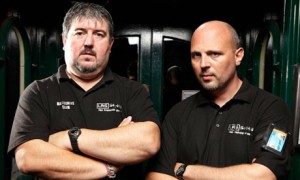 For the initiated, MonsterHunt is – as the name suggests – about hunting down monsters. It shares many characteristics with the original Unreal game, in which the player is moving from stage to stage, solving puzzles (which generally amount to “how do I get through this level? Where’s the switch/lever/tile that opens the gate/raises the portcullis/lowers the drawbridge/extends the platform?”) whilst encountering monsters along the way.
For the initiated, MonsterHunt is – as the name suggests – about hunting down monsters. It shares many characteristics with the original Unreal game, in which the player is moving from stage to stage, solving puzzles (which generally amount to “how do I get through this level? Where’s the switch/lever/tile that opens the gate/raises the portcullis/lowers the drawbridge/extends the platform?”) whilst encountering monsters along the way.
Despite its name, MonsterHunt isn’t necessarily about the hunt for monsters – they’re simply antagonists that impede progress in some way, whether it be guarding a specific pinch point or just coincidentally congregating at some particular area ready for transforming into cannon fodder. Whilst Unreal had specific objectives to accomplish before proceeding to the next stage, MH is simply a small bite-sized chunk of a stage, a brief journey of fighting your way to reach some huge end-of-level guardian, said beast blocking the final exit by virtue of being able to sustain an extrordinary amount of damage.
For the impatient, there’s Monster Arena (MA), which foregoes the laborious yet interesting journey and elects to immediately place everyone up against the final guardian, usually accompanied by some lesser cannon fodder to serve as a distraction from the prime objective. I thought I’d clarify the obvious difference between MonsterHunt and MonsterArena: one is experiencing a journey to Large Monster Death, the other cuts to the chase.
Yes, that’s an important point there: MonsterHunt is NOT MonsterArena.
With that in mind, I’ve been reviewing some MH maps, and.. unfortuntely, some are utter SHIT.
Oh, it’s not been a complete waste of time. I’ve certainly learned lots about off-world architecture and futuristic mechanisms. In particular:
1. Lifts Suck.
On Earth, lifts tend to be manual devices, requiring a button press to summon and usually another to activate. The future saw fit to do away with those pesky activation buttons; lifts automatically begin their ascent or descent upon detection of foot pressure, which requires everyone to embark at the same moment – those too slow will be left behind. No button to hold the doors for YOU, mister – autolift has began and you’re too late.
Now, this foot pressure detection can also be eccentric at times, often requiring multiple step on/off before activation begins. Every lift has its own random delay, so it’s not uncommon for players to mistime their stepping off/on then see it activate without them. To avoid looking stupid at missed lifts, players usually all hop on at the same time then simultaneously look stupid when attempting to start its motion by pogoing like someone’s just rediscovered “Pretty Vacant” on the jukebox.
And then there are lifts which automatically return to the lower levels, leaving you stranded higher up. Sometimes they’ll detect a player near the precipice and will obligingly rise to meet you. Mostly they’ll prefer you first plunge down to the lift shaft to your doom then elevate lumps of your broken corpse to serve as a warning to the other players: lifts are AUTOMATIC and they DO AS THEY DAMN WELL PLEASE.
2. Doors Suck.
These are similarly affected, in that no controls are usually evident. Instead, a proximity detector opens the door upon close contact, closing it behind you once safely through.
Well… that’s the theory. In practise, some proximity detectors are built into stout wood requiring you to smash your face repeatedly against the door several times before they’ll open. And once open, they’ll decide when to close, usually timing it perfectly to permit enemy attacks to pass unscathed but blocking your retailatory fire. Lacking manual controls, there’s no way to hold them open – someone’s got to stand boldly go in front to fling them wide – and absorb the first salvo in players’ direction.
And then there are portcullis of wood and doors of stone that are somehow linked to the health of a nearby monstrosity, barriers that remain steadfastly closed to all firepower yet magically spring apart as soon as Goliath keels over. It’s a tactic I may try at nightclubs: woe betide the bouncer standing nearby – for should they be put to the cudgel verily doth the entrance open, tie or no tie.
3. Stop Complaining.
No. Grumpy Mode On. Let’s be pessimistic for a moment and discuss the things that make bad playability:
- Texture glitches. Turning a corner and bumping into an invisible obstacle. Finding your feet stuck under a hill’s ledge. Walking straight through an opaque tree only to be tripped up by knee-high strands of grass. This just smacks of laziness and poor testing, and detracts from the gameplay terribly.
- Toe-stubbing architecture. I know temples and castles weren’t designed with comfort in mind, but it’s annoying when specific items are raised up on platforms requiring a small jump or step up to get to them. Yes, I know the ground isn’t perfectly level, but walking forwards only to be snagged by a ground bump, ledge, step, wall decor etc. is annoying. Staircases in other maps are perfectly navigable, what’s wrong with yours?
- BunnyTrack. It’s a slow, cautious… waste of time. I want to hunt monsters. I want to walk into a room and blast them. I want to run away from pursuing monsters to find cover. I don’t want to tippy-toe between suspended planks or levitating rock ledges of perfect rectangular appearance. Yes, have a narrow ledge to navigate. Have holes in bridges, gaps requiring a jump to traverse – or at least include it for optional stuff, such as gaining a megakegger or redeemer… but don’t make the player spend half an hour and several lives hopping from one tightrope to another only to fail at the last jump.
4. Really, Stop Complaining.
Okay, grumpy phase over. What makes a good map? Let’s clarify our value criteria here. Firstly, the map has got to be enjoyable. Good weapon placements, good routes, good adventure, long enough to be immersive, is a challenge for the players, has variety along the way… Notice I didn’t harp on about the textures, lighting, monsters, etc.; given the choice of plain and enjoyable versus beautiful but boring, I’m afraid the SuperModel gets the boot. I’m not denying some maps are beautiful to look at, but it makes it all the more tragic when effort is dedicated to polishing the scenery over fixing bad playability.
So let’s look at some examples of enjoyable maps:
MH-SkaarjTower – this map is fekkin’ hu ge.
ge.
I don’t mean big. I don’t mean VERY BIG, I mean throbbing monstrous overdosed on steroids. And yet despite its size, it’s relatively simple: three passageways snaking out from a central castle with a switch at the end of the first opening the passage for the second, etc.. It doesn’t have to be complicated; each passage contains lifts, water walkways, tight passages, building and cellars to seek out those elusive buttons and levers that open the way for further progress – all with various monsters to stop you.
Originally part of a single-player set for Unreal, this is the ultimate MonsterHunt map to me – nothing comes remotely close. MH-SkaarjCastle, but that’s not MH and contains an irritating time-chomping maze stage.
I played MH-CrystalMine-beta and enjoyed it, but MH-CrystalMineV4 is a radical redesign of that map, almost completely different – the beta stands up well on its own, but V4 makes the beta feel a bit plain and experimental.
Long, good enemies to splat, and a massive hauuugeeee Titan at the end that shrugs off rockets and eats redeemers for toothpicks.
Part of the Crystal Unreal series.
MH-TGES (The Great Escape) series are okay.
okay.
Originally I disliked the first one but gave it a bit more of a go and discovered it’s designed to be deliberately difficult, so it certainly requires patience.
It can be somewhat long and drawn-out, and a small number of players trying to grind down super-mega-tough armoured beasties can create repetitive periods of blast-die-respawn cycles so and definitely benefits from having several players cooperating.
Some later releases are variations of earlier incarnations, as though the map author responded to feedback and produced improvements as a new release, but are ruined by the self-respawning monsters. Now that’s a particular bugbear of mine – entering a room with a monster-count of 300, blasting away to clear the room, finding yourself overwhelmed and escaping from the room to see that the monster-count has dropped to… 372? Hold. The. Monkeyfarmer. Frontpage!
 Having said that, unlimited respawning monsters isn’t such a bad thing when done well. MH-LongCorridor2006 is a good example of that, but only when combined with InstaGib and MonsterHuntV2 mod that awards health bonuses for kills, so it’s possible to proactively build up a strong immunity to the next level.
Having said that, unlimited respawning monsters isn’t such a bad thing when done well. MH-LongCorridor2006 is a good example of that, but only when combined with InstaGib and MonsterHuntV2 mod that awards health bonuses for kills, so it’s possible to proactively build up a strong immunity to the next level.
The lack of respawn points is also frustrating… but that’s what makes it somewhat challenging – get through each wave without dying!
 MH-LostInTime is a two-stage map: it begins with a tunnel run to power up a teleporter that throws you into a large open-plain prehistoric area in which you’ll need to locate and depress several stones to find your way back (hell, why go through the time portal in the first place, you idiot?) whilst avoiding being trampled/bitten/pecked/spat/goured to death.
MH-LostInTime is a two-stage map: it begins with a tunnel run to power up a teleporter that throws you into a large open-plain prehistoric area in which you’ll need to locate and depress several stones to find your way back (hell, why go through the time portal in the first place, you idiot?) whilst avoiding being trampled/bitten/pecked/spat/goured to death.
Fundamentally the dinosaurs are simply standard Unreal monsters with different skins, and normally you can avoid them in your quest to find the stones – apart from where killing water diplodocus causes an Aztec temple to swing open its doors – but health-connected entrances and all that…








